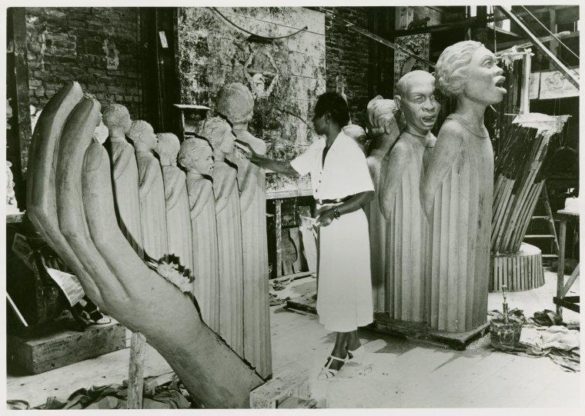WRITTEN BY MARKETING INTERN SHANNON MCFADDEN
Augusta Savage became a gifted sculptor, significant teacher, leader, and catalyst for change. Overcoming poverty, racism, and sexual discrimination, Savage became one of this country’s most influential artists of the 20th century, playing an instrumental role in the development of some of the most celebrated African American artists. A prodigious and highly acclaimed artist in her own right, Augusta Savage created works that elevated images of Black culture into mainstream America. A central figure in the Harlem Renaissance, she worked with other leaders, writers, musicians, and artists to showcase the contributions of African American culture. As a community organizer and teacher, Savage created a bridge between the first generation of Harlem Renaissance artists and subsequent generations of artists.

Augusta Savage at work on Lift Every Voice and Sing (The Harp), 1935-1945, New York World’s Fair (1939-1940). Photographs and Prints Division, Schomburg Center for Research in Black Culture, The New York Public Library, Astor, Lenox and Tilden Foundations.
Augusta Savage was born to Cornelia Murphy and Edward Fells on February 29, 1892, in Green Cove Springs, Florida. In 1921, Savage moved from Jacksonville, Florida to New York City to further her artistic skills and was admitted to the School of Art at Cooper Union for the Advancement of Science and Art. Like many Black artists of her time, Savage traveled to Paris to study er craft. After her return to New York, she opened her Harlem studio to the public, offering free art education and mentoring to a number of master artists. Because of the success of her studio and dedication to art education, the Federal Art Project of the Works Progress Administration invited Savage to open the Harlem Community Arts Center, which would serve as a model for art centers opening across the nation during the Depression. Shortly after opening the center, Savage participated in the 1939 New York World’s Fair and created her masterpiece Lift Every Voice and Sing (The Harp). After the critical success of her workin the fair, she opened a gallery, the Salon of Contemporary Negro Art, which was the first gallery in the nation to exhibit Black artists. After the closure of the Salon, she went back to teaching and moved to Saugerties, New York. She died of cancer in 1962.


